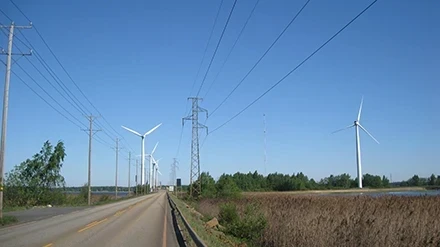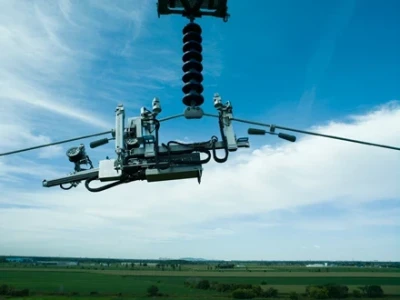Utility Pole Showdown: Wood vs. Steel

A recent study that takes an in-depth look at the environmental performance of wood and steel utility poles challenges current perceptions on the sustainability advantages of wood poles when compared with steel poles.
The detailed study, titled “Environmental Life Cycle Assessment of Southern Yellow Pine Wood and North American Galvanized Steel Utility Distribution Poles”, compares the use of galvanized steel and treated wood utility poles over a 40-year time frame. It includes basic environmental impacts usually omitted from Life Cycle Assessment (LCA) methodology such as land use, habitat disruption, loss of key species and the long-term effect on humans. The results shed new light on several longstanding assumptions and document steel’s overall superior environmental performance.
LIFE CYCLE ASSESSMENTS
A life cycle assessment study measures a product’s impact on the environment from the time it is created through the end of its service life. This particular study was published by SCS Global Services, a global leader in third party environmental and sustainability certification and standards development.
The peer-reviewed study focused on 45-foot-tall, Class 2/Grade B distribution poles and included their production, installation, maintenance and disposal or recycling. Two different scenarios were compared. First scenario included a business-as-usual (BAU) scenario in which wood poles taken out of service continued to be replaced by Class 2 wood poles. Second scenario included a steel pole replacement (SPR) scenario in which wood poles taken out of service were replaced with galvanized steel utility poles. The study was conducted in compliance with international LCA standards (ISO-14040-series).
Conducted in 2013, the study is the most comprehensive environmental assessment of its kind to date, bringing a new level of transparency to the comparative performance of these two material choices. It was commissioned by the Steel Market Development Institute (SMDI), a business unit of the American Iron and Steel Institute. Some results from the study follow.
STEEL UTILITY POLES
The study assessed and quantified 35 independent category indicators. It demonstrated several advantages for the Steel Pole Replacement (SPR) scenario.
#1
Lower levels of greenhouse gas emissions
When considered over the entire 40-year time horizon, the accumulated emissions contributing to global climate change are higher in the BAU scenario, when wood poles are replaced with more wood poles. The major contributors to these results are the installation of the wood poles; the electricity generation required for the production of chromated copper arsenate (CCA), the chemical used to treat wood poles; and the production of wood from Southern yellow pine from forest management practices including short-rotation, even-aged forest management. These forest management practices in the Southeastern U.S. result in losses of forest carbon storage of between 20 to 30 percent, equivalent to the loss of storage of 20 to 40 tons of carbon dioxide per acre. In the scenario where galvanized steel poles replaced the treated wood poles, the largest contributors to global climate change are the production of steel, galvanization, and zinc smelting.
#2
No terrestrial biome disturbance to forests
The United States Forest Service estimates that in 2009 in the Southeastern U.S., roughly 55 million acres were covered in Loblolly-shortleaf pine forests, and 13 million acres were covered in Longleaf-slash forests, the two predominant forest types from which the southern yellow pine used to produce wood utility poles is sourced. Most forest management in the region utilizes even-aged forestry in “plantation” stands, where entire stands of forest are cut at one time, and allowed to re-grow before being cut again on a regular cycle. In the Southeastern U.S. in 2007, 159 million out of 200 million acres were in plantations, accounting for nearly 80 percent of all timberland in the region.
This type of forest management creates a landscape consisting of a patchwork of forests in different age classes. Of the managed forests considered in the study scope that are producing Southern yellow pine, 97 percent are 40 years old or less, and 75 percent are less than 20 years old. These forests are maintained in an altered state compared to a mature forest, resulting in a set of land use ecological impacts that have altered plant communities for the “temperate broadleaf and mixed forest” biome and the “temperate coniferous forest” biome. The plantation-style forestry in this region created a landscape that is, on average, between 40 percent and 60 percent disturbed, when compared to a mature forest.
#3
Less habitat disruption for endangered species
Key species identified on the U.S. Forest Service Threatened and Endangered Species List or the International Union for the Conservation of Nature Red List of Threatened Species were considered. When wood poles replaced wood poles, almost 90 species were affected, and seven of those species experienced disturbance to terrestrial habitats, for which indicator results were assessed. An additional 81 of these species experienced disturbance to freshwater and/or wetland habitats; however, indicator results could not be quantified for these species, due to a lack of data.
#4
Lower generation of untreated waste
At the end of their service lives, CCA-treated wood poles are removed and typically landfilled, but may also be reused or incinerated. The disposal of CCA-treated wood poles presents a risk to human health and the environment if these poles are disposed of in municipal landfills. In contrast, steel pole production results in negligible untreated waste, because virtually all steel material is recycled into new steel products.
WOOD UTILITY POLES
In the study, the BAU scenario, where wood utility poles replace other wood poles, demonstrated advantages in the following impact categories:
#1
Lower land use ecological impacts
Both scenarios affect different regions with different biomes and species affected. The steel pole replacement (SPR) scenario results in impacts to three terrestrial species and one biome in the Mesabi and Marquette Iron Ranges. These impacts include disturbance to Western Great Lakes forests and the habitat of the Kirtland’s warbler, Wood turtle, and Blanding’s turtle.
#2
Lower zinc resource depletion
For galvanized steel utility poles, zinc provides a sacrificial coating, and very little zinc is recovered at end-of-life. Including both primary and secondary zinc resources, the United States Geological Survey (USGS) estimates that there are nearly two billion tons total of zinc resources in the world. While there is a volume of retrievable reserves of secondary zinc that meet or exceed the current reserves of primary zinc, it is anticipated that the price of primary zinc will increase as primary reserves are depleted, resulting in increased zinc recycling.
In the SPR scenario (steel poles replacing wood), consumption of zinc resources is a very small portion of total primary zinc production, with an annual average consumption of approximately 650 tons over the study time horizon―less than 0.005 percent of the total world primary zinc production in 2012, according to the USGS. While contributing to the depletion of a significant resource, the depletion of zinc in the SPR scenario is not considered a major driver of zinc resource depletion globally.
COMPARISON OF MATERIALS
Traditionally, utility company managers have replaced their wood distribution poles with more wood poles as standard practice. However, as managers face greater power demand from customers and reconsider the current methods of maintaining and replacing their poles, environmental performance is becoming more important in the decision making process. ET
Mark Thimons, P.E., LEED AP – BD&C, is Director, Construction Sustainability for the Steel Market Development Institute, a business unit of the American Iron and Steel Institute.








